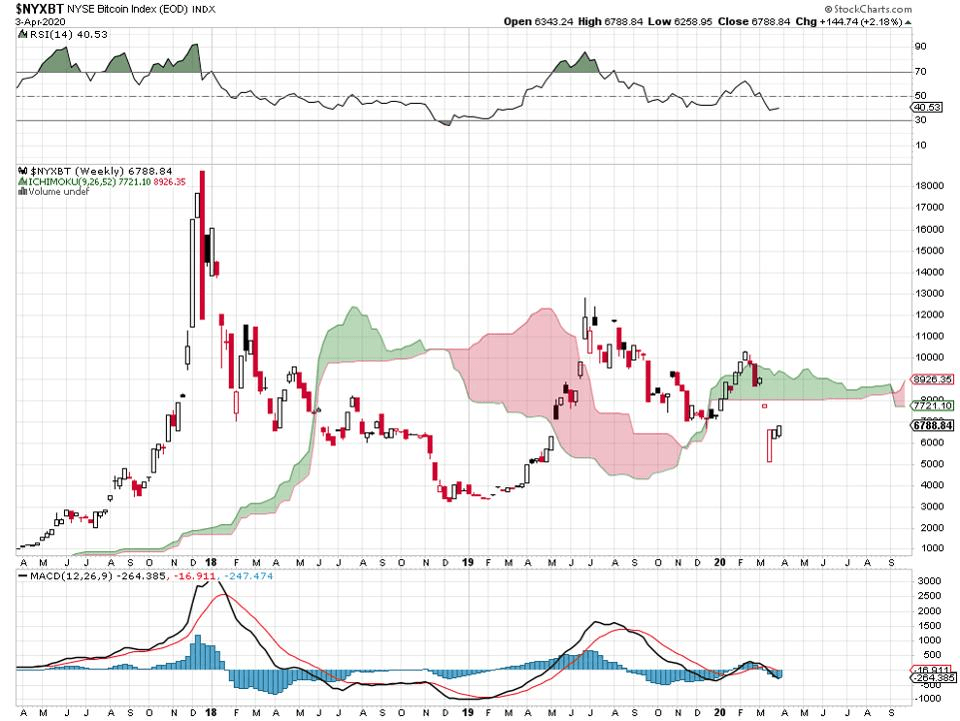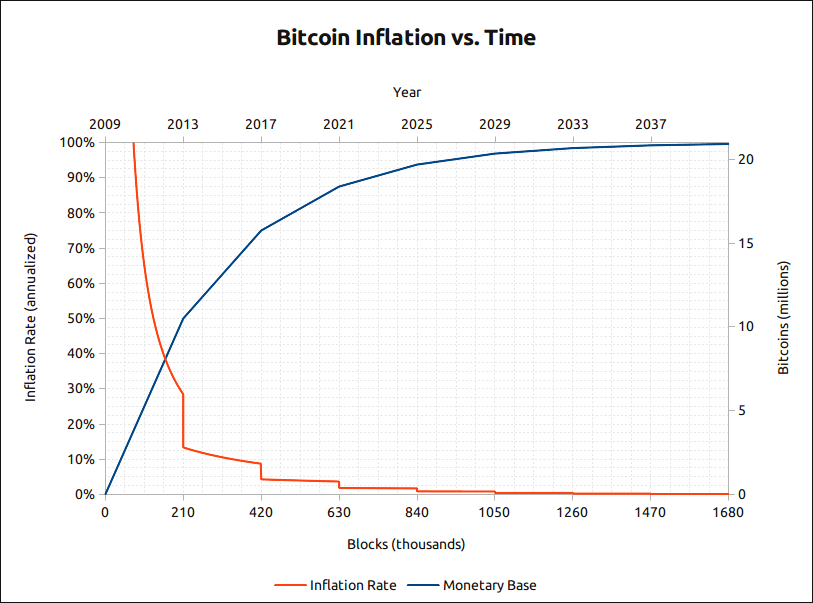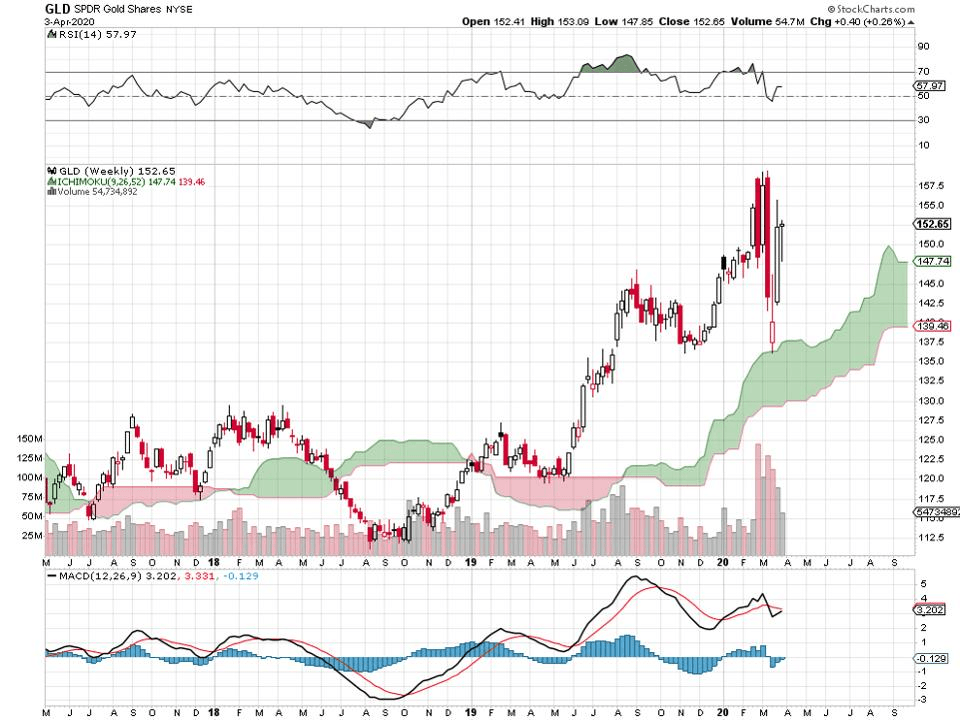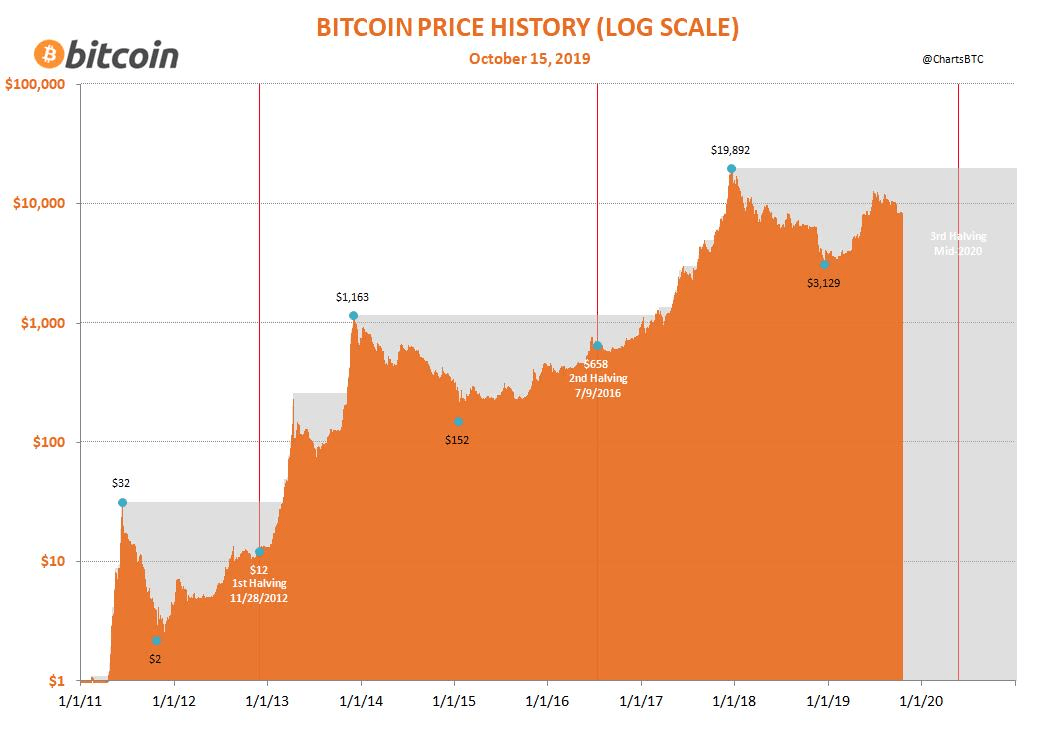About once every four years, an important event occurs in the world of cryptocurrencies - the Bitcoin halving. The frequency of this event is probably quite easy to remember for sports fans. The year of halving coincides with the year of the Summer Olympic Games and the European Football Championship. So it was in 2012 and 2016. These events would have lined up again in 2020, but for the COVID-19 pandemic. As a result of the pandemic, the Tokyo Olympics have been canceled along with all public events, but the halving will take place according to plan. With all the pandemic turmoil caused by travel bans between the U.S. and Europe and the ongoing volatility in all financial markets, traders and crypto enthusiasts have just one question: what is going to happen to BTC and altcoins this May and how will the upcoming event change the market?
Halving Q&A
A halving is an automatic reduction of profitability from mining by half, which is an inherent part of the Bitcoin blockchain structure. The idea behind Bitcoin and altcoins with Proof-of-Work consensus algorithms is that miners perform calculations using their computer capacities, for which they receive a reward. In order to complicate BTC production, every 4 years there is a 50% decrease in the mining reward.
The goal of halving is to create a kind of coin shortage. In theory, halving should lead to a portion of Bitcoin miners curtailing mining that has become too wasteful, thereby reducing the growth of supply in the token market. A decrease in supply along with the ever-increasing demand for Bitcoin will automatically raise the price of the coin.
Initially, halving was an exclusive feature of BTC, which made the coin a pioneer in this direction. The first BTC blocks brought miners 50 coins each. If the size of the reward had not changed, then the entire 21 million coins would have been mined back in 2016. In order to avoid maxing out the supply so quickly, Satoshi Nakamoto proposed a very simple and ingenious solution: periodically reducing the block reward.
The size of the block reward was:
- Before 2012 - 50 coins per block.
- From 2013 to 2016 - 25 coins per block.
- Since 2016 - 12.5 coins per block.
Starting from May 22, 2020, the reward will be 6.25 Bitcoins per block. Messari, Bitcoin and crypto data researchers, note that Bitcoin miners will not only face marginal pressure as a result of a decrease in cryptocurrency output, but they may also feel pressure as a result of the price decline caused by the coronavirus, which has the potential of accentuating the negative effect of the reduction. If this is true, then the impact on miners will be colossal.
In theory, a decrease in mining profitability should lead to an outflow of miners and, accordingly, an increase in prices. However, the way this has worked in the past shows that the price usually begins to rise several months before the event and after halving it can either fall or once again start growing.
Hashrate is the total power of computing equipment that is used to mine cryptocurrency. A recent BitMEX study analyzed the potential impact of the upcoming halving. According to one scenario, the hashrate of the network may decrease by 29%. Over the past month, the Bitcoin hashrate has dropped from 127E to 109E. Accordingly, the question of what will happen to this indicator after halving becomes even more relevant.
There is a special website with a live Bitcoin block reward halving countdown and detailed data on the upcoming halving. Here you can learn about the predictable monetary supply and view this inflation graph.
Source: bitcoinblockhalf.com
Bitcoin does have a very low inflation rate, which is considered to be one of its main advantages over altcoins. Satoshi Nakamoto created BTC fending off the major drawback of fiat currencies. In essence, Bitcoin’s mechanism of operation is somewhat reminiscent of gold. Gold reserves on Earth are limited and it was easy to mine only at the beginning of history. Over time, gold became more and more difficult to mine, since it was necessary to drill deeper and deeper into the ground. Since gold reserves on earth are limited, it has managed to maintain its value over the past 6,000 years. That is why Nakamoto made Bitcoin resemble gold, limiting its offer, giving it a margin of value and complicating mining as more and more coins appear in the world. The goal was to make Bitcoin maintain its value for many years.
Satoshi’s plan has been a success so far. But the question is - will Bitcoin outperform altcoins after the halving 2020, or is it safer to abandon BTC and invest in other cryptos?
BTC Pros and Cons:
+ Low Inflation Rate
The inflation rate has a significant impact on the price of an asset in the medium and long term. Many economists share the opinion that low inflation is the key to Bitcoin's success. The Block's analyst Larry Cermak came to the conclusion that the first cryptocurrency and its popular forks - BCH and BSV - have the lowest annual inflation rates among the most capitalized assets. Bitcoin's current inflation rate is at 3.88%, while Ethereum is at 4.77%, which is approximately two times lower than Ethereum Classic. After the May halving, Bitcoin’s inflation rate will drop to ~ 1.8%.
+ Halving Statistics
Historically, halving has been a key catalyst for moving Bitcoin into a new bull market. The BTC price tends to rise both before and after halvings. In fact, the price of Bitcoin reached new historical highs in the months following a halving. If you study this BTC price chart, you can observe a certain similarity in the price rally of both halving cycles.
Source: Bitcointalk.org
In each of the previous halving cycles, the BTC price spiked from the lower values of the bear market before halving to the peak of the bull market after it, in both cases increasing by 12000–13000%. Accordingly, in 2020, BTC can repeat this price pattern and set another historic maximum.
+ Recent Hashrate Growth
The estimated hashrate of the Bitcoin network grew by 33% in two days, and the price followed suit. The Bitcoin hashrate rose from 91.3 TH/s on April 4 to 121 TH/s on April 6. Historically, hashrate and price have shown a close correlation at 0.77. If the correlation of hashrate and price continues, the market may soon show a significant increase. According to Charles Edwards, head of digital assets at Capriole investment firm, the growth of hashrate is an obvious sign of the current strength of Bitcoin.
+ Analytical Research
Fundstat expert Thomas Lee published a positive 2020 Crypto outlook on Twitter. The trusted, evidence-based research provider stated that the financial markets “tend to discount 1-3 months, and maybe 6 months” at most. So there is a high probability that “halvening (is) not priced in.” For 2020, Fundstat sees several positive convergencies that enhance the use case and also the economic model of Bitcoin. They believe BTC’s total return should exceed that of 2019 and gain more than 100% in 2020.
Bloomberg predicted rapid explosive growth for Bitcoin. For the first time since the beginning of January 2020, a signal about a close rally appeared on the chart of the first cryptocurrency. Experts refer to the technical indicator DVAN that last gave a bullish signal in early January when Bitcoin was trading around $7,000. After a month and a half, BTC was above $10,000.
Galaxy Digital founder Mike Novogratz, known for building a fortune on Wall Street and setting his sights on crypto, believes Bitcoin could double its value over the next six months. In a recent interview on CNBC’s Closing Bell, Novogratz explains he’s bullish on Bitcoin because the “governments have forgotten the old adage that money doesn’t grow on trees.” He points out that growth in BTC trading volumes to the levels before the March 12 collapse indicates an interest in the original cryptocurrency.
According to the CEO of Social Capital and Chairman of Virgin Galactic, Chamath Palihapitiya, now is the time for a new strengthening phase for Bitcoin. The billionaire earlier said that Bitcoin is “a fantastic hedge” and that everyone should have 1% (not much, right?) of their assets invested in it as “insurance under the mattress.” He believes the fall of the traditional financial system will help BTC gain the status of "gold 2.0" by 2030. But does Chamath truly believe in the new “quasi gold standard” if he recently called Bitcoin a “schmuck insurance” that he hoped he would never need?
- Too Far from Gold
Back in 2019, analysts believed the price of $385,000 per BTC was a realistic prospect, implying that Bitcoin will surpass gold in market capitalization. This, of course, could greatly strengthen the status of Bitcoin as "digital gold," but let’s face it - the current figures are too far from last year’s ambitious predictions. With BTC, rallying from mid-March to the present, from just under $5.250 to just above $6.700, but never regaining its early February high of $10.250, we can see a series of lower highs and lower lows.
This is Bitcoin’s weekly price chart:
Source: STOCKCHARTS.COM
The highs can’t be compared to the ones from June/July, 2019 and the late 2017 all-time highs above $18.000. Along with that, BTC hasn’t yet been able to climb above the Ichimoku cloud.
Take a look at the gold weekly price chart:
Source: STOCKCHARTS.COM
The precious metal demonstrates a stable uptrend. Naturally, this March the price sank below the November/December lows, following the market. But, despite the extraordinary massive levels of selling, it never fell under the up-trending Ichimoku cloud. Regarding that, why would investors choose Bitcoin over gold if the latter investment vehicle might work better as a “store of value?”
- Negative Prognosis
The crypto world is watching every move of BTC trying to predict if it’s worth investing in. Historically, Bitcoin halvings lead to accelerated price rises. However, the well-known cryptanalyst Willy Wu noted that it’s the first time BTC has reduced the reward for the block against the backdrop of a bearish balance of power. By the way, he adheres to a negative scenario. Wu believes that a “Black Swan” event has already taken place in cryptocurrency and traditional markets, and the effect of its arrival has yet to be seen.
CoinMetrics analysts believe that Bitcoin can repeat the Litecoin halving script - “waiting for growth and collapse.” Litecoin creator Charlie Lee agrees with them.
In his March 17 tweet, Peter Brandt, a famous cryptocurrency trader and trading chart analyst, explained that he considered Bitcoin's daily trading volume to be the real cryptocurrency offer. Moreover, the reduction in daily BTC mining after halving is equivalent to about 0.02-th part of 1% of the real supply.
The volume of reduction of new coins after halving events is very small - it does not exceed two-hundredths of one percent of the total cryptocurrency trading turnover per day. In other words, Brandt suggests that such a change is not enough to make the asset rare and scarce, or, in other words, to make it moon, given the negligible effect it will have upon demand.
Altcoins Pros and Cons:
+ Technical Advances and Vast Ecosystems
A lot of altcoins are designed to make users’ lives better. Their developers have created mechanics, infrastructures and ecosystems that go a step beyond those of BTC. Even former Bitcoin promoter and famous antivirus creator John McAfee called Bitcoin “worthless,” when compared to Ethereum, Monero and DAI in terms of technical specifications. “It's widely used among tens of thousands of us who no longer use banks, credit cards or paper currency. There is nothing that you need that can't be bought through DAI, Monero or Ethereum. Homes, cars, hotels, air travel, food etc.” - McAfee shared on his Twitter.
+ Alts are Taking Over the Market
Of the top 100 Coinmarketcap rated coins, the leader in daily transactions is USDT, a stablecoin with an indicator of $63 billion and a market capitalization of $6.3 billion. Bitcoin is in second place with a trading volume of $47 billion and a capitalization of $133.5 billion. See, Bitcoin is not always the “number one crypto.”
- High Inflation Rate
As we have discussed, the high inflation rate (i.e. depreciation) of altcoins is another reason to give preference to Bitcoin as the main investment vehicle in the industry. Veteran trader Peter Brandt, who is famous for his correct market predictions, said that 99% of all current cryptocurrency projects are doomed to oblivion. He explained users will get rid of the coins whose value is constantly falling due to high inflation.
In 2019, Alex Kruger posted on his Twitter the research on the emission level of several popular coins. As it turned out, projects like Zcash and XRP completely lose to Bitcoin in this matter. Kruger attached two tables with inflation data on various crypto projects. The first table of Live Inflation Rates was topped by Zcash with 35.79%. And Ethereum Classic had the lowest inflation rate at 1.17%. The second table presented altcoins with a fixed level of annual inflation. XRP ranked first with a score of 27.89%. Keep in mind that the Ripple Foundation issues a billion tokens every quarter. The crypto community believes that this policy harms coin pricing. Some have even suggested creating a petition against XRP cost dumps.
- Unpredictable Price Fluctuations
Developers and even analysts sometimes can not explain why the price changes. For example, the growth of Litecoin in April 2019 was generally associated with the upcoming halving, but in fact, it is quite possible that the growth was provoked by other factors. It is also worth noting that there are many cryptocurrencies with the PoW protocol, but the attention of investors is focused only on the BTC, BCH and LTC halving. It seems that with other alts, it either does not have any influence on the price at all, or the mechanism for halving returns is not embedded in the blockchain regardless of the consensus algorithm. Even though in April 2019 LTC and EOS were in the lead, later XRP and Tether took over. It came as a bit of a shock that on April 7, the price of Ethereum, the second biggest cryptocurrency in terms of capitalization, jumped to $176. As recently as mid-March, it was priced below $90.
A Brief Conclusion
It's no secret that the leading cryptocurrencies are closely connected and display similar market dynamics. Many experts have noted the high correlation of altcoins with the BTC exchange rate. Accordingly, the 2020 Bitcoin halving is also contributing to the growth of other cryptocurrencies.
There is no single opinion on the forthcoming halving. Enthusiasts suggest that the "pre-halving rally" is in full swing, and BTC is going to pull the entire market. Some traders are predicting that the reduction in the supply of coins in the market will significantly increase the demand for them, so the price of Bitcoin will moon. But other enthusiasts are experiencing something of a comedown from Bitcoin. For instance, McAfee believed BTC will reach $1 million and has repeatedly spoken out in favor of his prediction and only in January of this year, he admitted that it was a trick he used to attract people to the crypto space. Despite being more bullish than bearish, Peter Brandt is now warning that a Bitcoin under $1K is possible.
Influencers may change their opinions. But when it comes to trading, once the money is lost, nothing can be changed. That’s why, if you trade, it is so important to do your own research and stick to liquidity providers that enable users to buy and sell cryptocurrency at the best value as quickly as possible. According to Coinmarketcap, HitBTC is the cryptocurrency exchange with the highest liquidity, which has given its users as much of a safety net as there is in the volatile world of digital asset trading. Also, when choosing a crypto broker from the top-10 crypto exchanges - Bitfinex, Kraken, OKEx, a lot depends upon your trading strategy. If halving is already fully embedded in prices, the market will likely see an implementation of the “buy by rumor, sell by facts” strategy, which could lead to a decrease in the price of BTC. Altcoins with a high direct correlation with the Bitcoin exchange rate, such as Ethereum (ETH), Litecoin (LTC) or Monero (XMR), could follow the price of the BTC in the long run. However, in any case make sure to employ an effective and reliable risk management strategy, if at the time of halving you intend to implement speculative trading in Bitcoin or altcoins.
Note: All information on this page is subject to change. The use of this website constitutes acceptance of our user agreement. Please read our privacy policy and legal disclaimer. Opinions expressed at FXstreet.com are those of the individual authors and do not necessarily represent the opinion of FXstreet.com or its management. Risk Disclosure: Trading foreign exchange on margin carries a high level of risk, and may not be suitable for all investors. The high degree of leverage can work against you as well as for you. Before deciding to invest in foreign exchange you should carefully consider your investment objectives, level of experience, and risk appetite. The possibility exists that you could sustain a loss of some or all of your initial investment and therefore you should not invest money that you cannot afford to lose. You should be aware of all the risks associated with foreign exchange trading, and seek advice from an independent financial advisor if you have any doubts.
Recommended Content
Editors’ Picks

Chainlink looks at $14 resistance as outflows from exchanges signal continued demand
Chainlink exchange outflows exceed $120 million in the last 30 days, hinting at increasing accumulation. The breakout from a falling wedge technical pattern and an uptrending RSI indicator signal stronger bullish momentum.
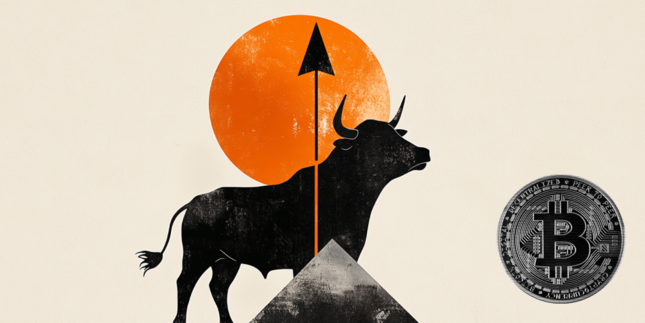
Bitcoin extends gains toward $90,000 as ETFs inflows exceed $381 million
Bitcoin is extending its gains, trading above $88,000 at the time of writing on Tuesday after rising nearly 3% the previous day. Institutional demand seems to be supporting BTC’s recent price rally, with US spot ETFs recording an inflow of $381.40 million on Monday.

Top 3 gainers Fartcoin, POL, DeepBook: Altcoins surge as Bitcoin nears $90,000
Investors in select altcoins like Fartcoin, POL and DeepBook welcome double-digit gains. Bitcoin inches closer to $90,000, potentially waking up as digital Gold amid uncertainty in the macro environment.

Hyperliquid updates validator to 21 permissionless nodes, HYPE price breaks out
Hyperliquid’s validator update allows anyone to register, with the 21 largest stakes forming the active set. Validators must lock up 10,000 HYPE for one year, whether in the active set or not.

Bitcoin Weekly Forecast: BTC holds steady, Fed warns of tariffs’ impact, as Gold hits new highs
Bitcoin price consolidates above $84,000 on Friday, a short-term support that has gained significance this week. The world's largest cryptocurrency by market capitalization continued to weather storms caused by US President Donald Trump's incessant trade war with China after pausing reciprocal tariffs for 90 days on April 9 for other countries.

The Best brokers to trade EUR/USD
SPONSORED Discover the top brokers for trading EUR/USD in 2025. Our list features brokers with competitive spreads, fast execution, and powerful platforms. Whether you're a beginner or an expert, find the right partner to navigate the dynamic Forex market.
